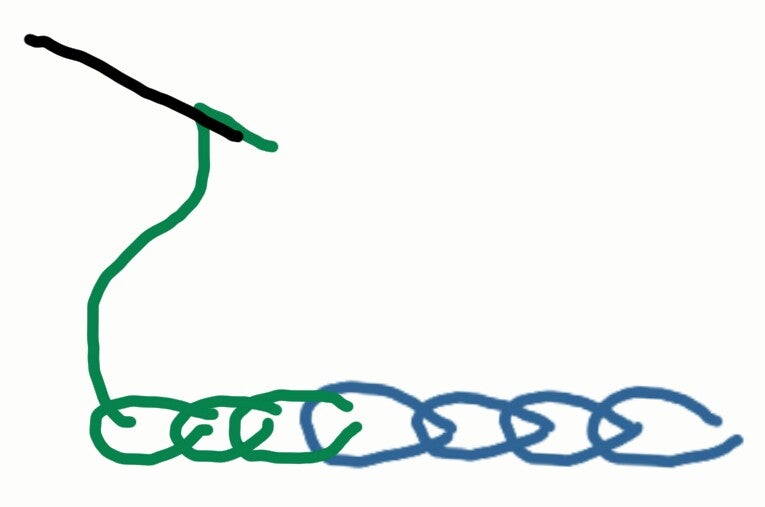これは一般的な方法ではありません。
私が日常的に用いている方法です。
玉結びを作らない糸の終わり方と始め方です。
This is not a common method.
This is a usual method for me.
It's a method of connecting threads
It is how to connect threads without a thread knot.
そろそろ糸が足りなくなってきました。
A thread is not enough.
最後のオホの根元に針を落とします。
Insert the needle to the base of the last oho.
後ろに何目か戻します。
Go back to several stitches.
糸が太い場合はランニングステッチで戻ります。
糸が細い場合はバックステッチで。
Back with running stitch when the thread is thick.
With back stitch when the thread is thin.
布を裏に返し、いま戻ったばかりの糸に絡ませます。
Reverse the cloth, and pass the needle through the thread which just returned.
刺繍糸や絹糸などの細くて抜けやすい糸は、途中で小さな玉結びを作ったほうが良いでしょう。
糸端は3mmを残して切ります。
You had better make a small thread knot at the middle if it's thin thread like embroidery thread or silk thread.
Cut a thread edge left 3mm.
なぜ3mm残すのか?
刺繍が終わったあとにもう一度「湯通し」をしますが、その湯通しの際に残った糸の繊維が絡まりあって、よりしっかりと糸は抜けにくくなります。
3mmは、その繊維が絡まり合うために必要な長さです。
Why I leave 3mm?
We desize again after we embroidery.
Then the fiber of the thread gets twisted up, the thread becomes hard to fall out much more.
Length of 3mm is necessary for fiber to get twisted up.
さて新しい糸です。
A new thread.
ランニングステッチをして、前の糸が終わった場所から針を出します。
Running stitch, and take out a needle at the place where the last stitch.
かなりガッチリ縫わさってますから。
I think that you may cut this thread edge at the base.
Since it is sewn hard.
この方法は小川早苗先生の「アイヌ民族もんよう集」の中でも紹介されています。(p.048)
This method is introduced in "the patterns of Ainu people" by Sanae Ogawa. (P.048)
なぜ玉結びを作らない方法を考えているのか。
それは耐久性を保つためです。
Why do I think about the way without a thread knot?
It is to keep the durability.
玉結びを作ると、玉は裏でふらふら動きます。
ふらふら動く玉結びはいずれ切れたりほどけたりして、糸が表に抜けてくる原因となります。
The thread knot moves on the reverse side (inside).
ほらっ!!(裏です)
玉結びが解けています。
This!! (It's the reverse side)
The knot comes loose.
ここはヤアシシシキリでやむ無く玉結びをしたところ。
This is the place of yaasissikiri where I have to make a thread knot unwillingly.
今後はもっと良い方法を思いつくかもしれません。
でも現段階ではこの方法を用いています。
Possibly I may conceive of a better idea in my future.
But I use this way now.
すいません、研究熱心で。
Excuse me, I'm earnest.
ま:ちょっと
言ってみたかったのよ。
I wanted to say it once.
な:へ〜〜〜。:ゆ
Na:Heeeeeeee:Yu
Nao Kodaira:
the gold medalist of 500m speed skating of the Pyeongchang Olympics
※This pose is called "へ he".
It's because this pose resembles a letter of the "へ he".
"へ he" is the trademark pose of Hanyu kun.
("Parisian's walkway" at the Sochi Olympics)
これを英語で説明するのは小っ恥ずかしい。










